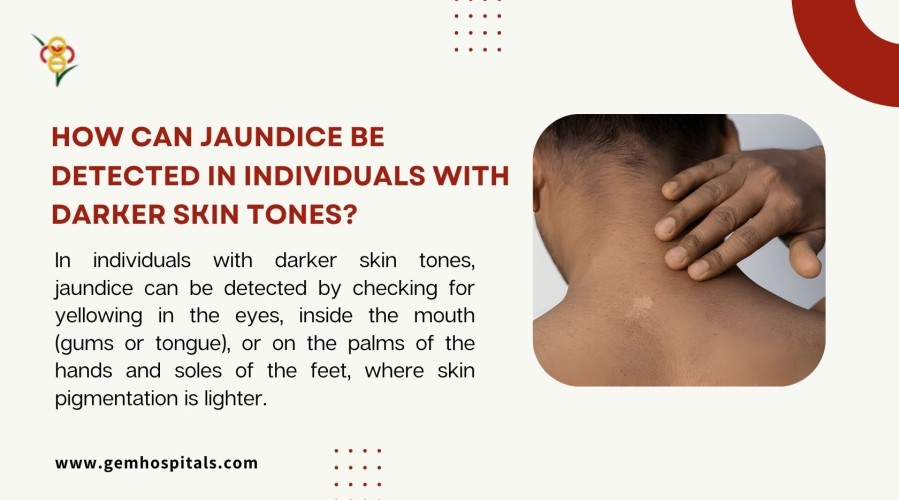Food poisoning is common during the monsoon. Learn when it becomes serious, how it can lead to pancreatitis or liver damage, warning signs, and when to seek medical care.
How can jaundice be detected in individuals with darker skin tones?

Jaundice is one of the most common health conditions which is caused by the accumulation of bilirubin in the blood that is characterized by the yellowing of skin and eyes. However this condition is a little difficult to identify in dark-skinned individuals because the skin yellowing is not heightened in them they are less visible, in this case, only healthcare professionals help you in adopting alternative methods for identifying jaundice. Jaundice should be identified in its earlier stage to treat it promptly and to prevent complications to the liver. The content below will assist you in knowing how this jaundice is identified in an individual with darker skin tones, the challenges in detecting it, and best practices for accurate diagnosis.
Why jaundice is harder to detect in darker skin tones?
The pigmentation of darker skin can mask the yellowing associated with jaundice, as melanin, the pigment responsible for skin color, obscures the appearance of bilirubin beneath the skin. This can lead to delays in diagnosis and treatment, as jaundice may go unnoticed until it progresses to more advanced stages.
In contrast to light-skinned individuals, where jaundice is most visible in areas such as the face and extremities, those with darker skin tones may not exhibit these signs as clearly. Relying solely on skin color to detect jaundice can lead to missed or delayed diagnoses, which can exacerbate the underlying cause of the condition.
Signs of jaundice in darker skin tones
To overcome the challenges of detecting jaundice in individuals with darker skin, healthcare providers must pay attention to alternative indicators. These include,
- The whites of the eyes, known as the sclera, are the most reliable indicator of jaundice, regardless of skin tone. Yellowing of the sclera is often the first visible sign of jaundice. In darker-skinned individuals, examining the sclera is critical, as it offers a clear contrast against the surrounding tissue.
- Jaundice may also manifest in the mucous membranes, particularly in the gums, inside the mouth, or under the tongue. In darker-skinned individuals, the yellow discoloration may be more noticeable here than on the skin. These areas should be examined carefully to detect subtle color changes.
- The nail beds are another area where jaundice can be detected in people with darker skin tones. While skin pigmentation may obscure the yellowing on the face and extremities, the nail beds provide a less pigmented surface that can highlight bilirubin accumulation.
- Dark urine is a common symptom of jaundice due to the excess bilirubin being excreted through the kidneys. For individuals with darker skin tones, changes in urine color may be a more noticeable indicator of jaundice than skin yellowing.
- Another sign of jaundice is pale or clay-colored stools, which result from reduced bile flow. A patient’s bowel movements can provide important clues about liver function and jaundice, particularly when skin color changes are difficult to detect.
Best practices for detecting jaundice in darker skin tones
To ensure accurate diagnosis, healthcare providers should follow these best practices when assessing jaundice in individuals with darker skin tones, use a multisystem approach, ask about other symptoms, and utilize diagnostic tests early.
Detecting the jaundice in darker skin tones may be a challenging thing because due to the higher melanin pigment, the yellowing of skin will be less visible. Here, focusing on other signs and symptoms can provide handy information about the on-sight of jaundice in an individual, it may include sclera, mucous membranes, nail beds, and urine color. During this visit, the healthcare providers can ensure timely and accurate diagnosis. Be aware and be proactive to preserve your health.
For early diagnosis or preventive care, consult the specialists at Gem Hospital.
Contact us today for expert guidance and personalized treatment options!
Blogs & Article
UTI cases often rise during the rainy season. Learn why urology patients need extra precautions, common causes, symptoms, and prevention tips to stay healthy during monsoon.
Monsoon humidity can worsen endometriosis pain and bloating. Learn how weather changes affect symptoms and discover practical tips to manage discomfort during the rainy season.


